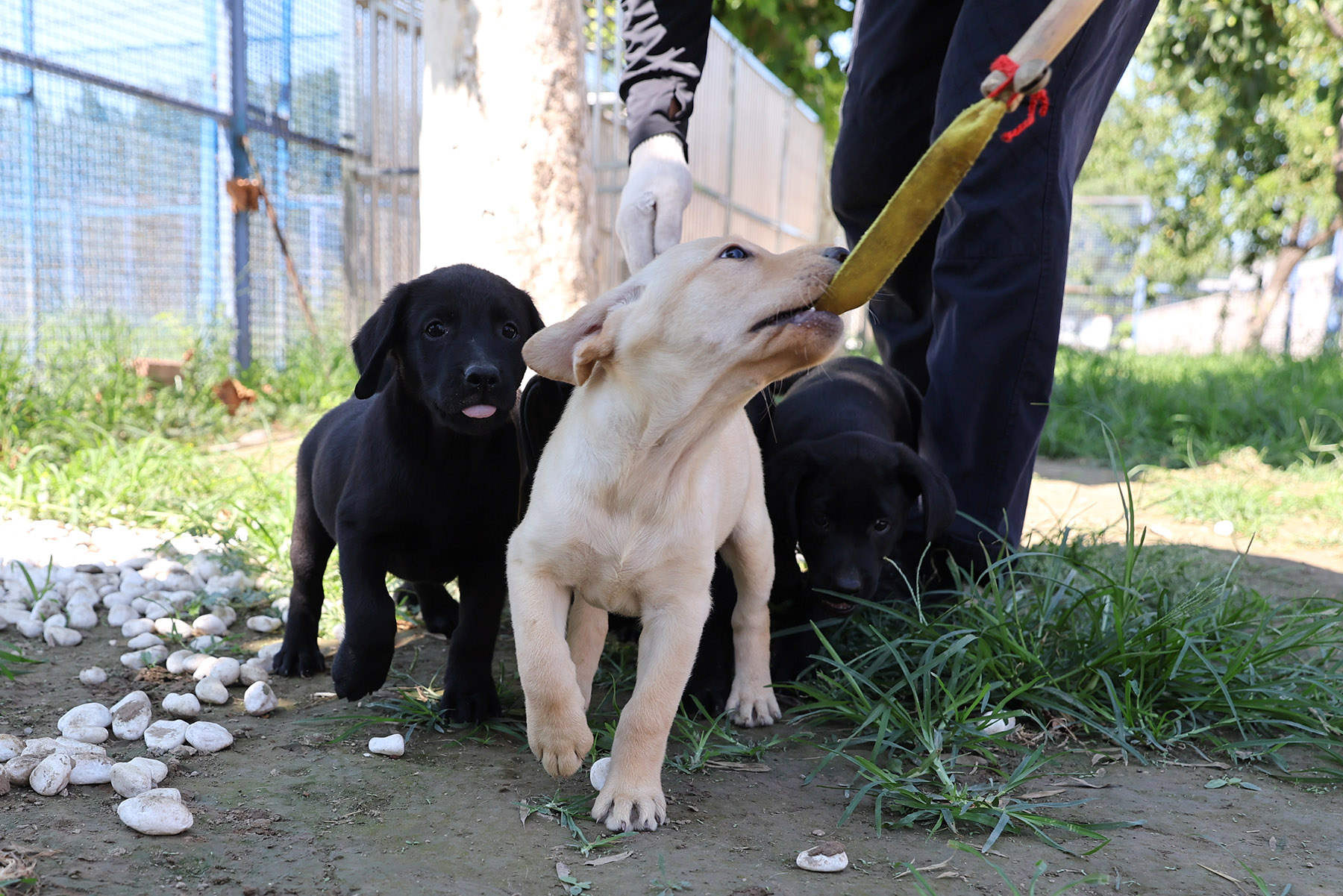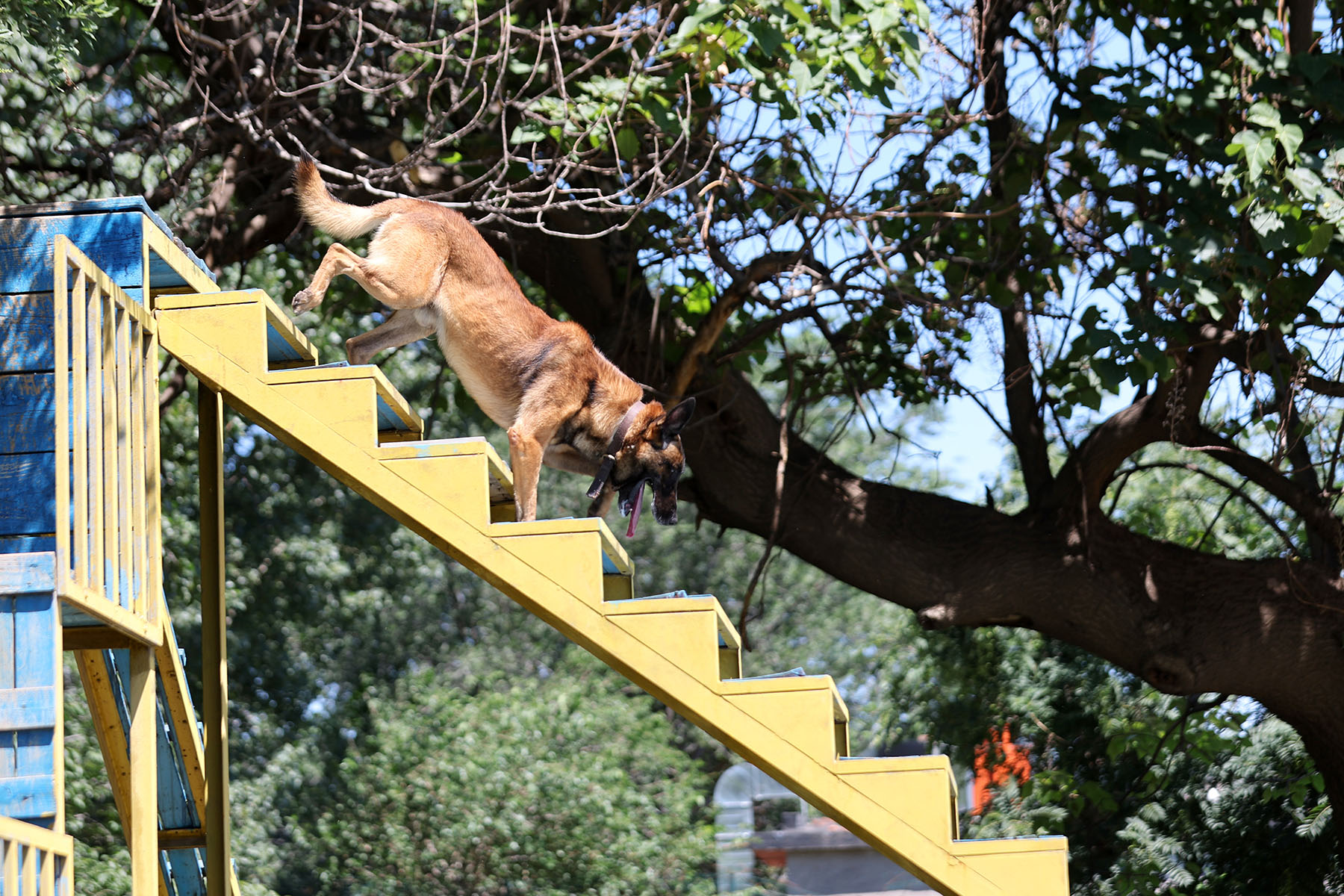As police dogs play growing role in investigations, canine handlers optimize training methods earlier

When 23-year-old Zhao Yingxi collected her first police dog for training in 2020 she had little choice in the matter.
She and her fellow dog handlers had drawn lots for the puppies and she ended up with Ujan, a 1-year-old male German shepherd that already weighed a whopping 40 kilograms.
Zhao is a slight woman, and it is hard to imagine the then novice dog handler training such a large, strong animal. When she first encountered Ujan, the puppy’s body almost filled its entire kennel.
She thought of exchanging the dog for a more docile one. “Ujan is a demanding dog and I had a really hard time,” Zhao said.
The puppy refused her simple command to sit, for example, and Zhao felt she had no affinity with the dog, which made her feel depressed. “Other dog handlers also took care of Ujan, helped train him, and took him to the sports ground for competitions such as tug-of-war. He behaved quite well and excited with them, not like with me,” she said.
The frustration continued, and Zhao-Ujan were the only team to fail the first assessment. After that, Zhao adjusted her mindset and encouraged Ujan more, allowing him to rest between training sessions.
The situation improved, and Zhao adopted a different training approach for Ujan. Instead of disciplining him, she focused on activities he enjoyed.
In China, police dogs play an important role in criminal investigations. The canines are trained to search for blood and material evidence, track narcotics, and even combat criminal suspects.
There are more than 14,000 police officers nationwide handling over 29,000 police dogs on active duty, data released by the Ministry of Public Security last September showed.
Public security organs at all levels have police dogs as a supporting force, and each category of police work has a proportion of canines based on needs.
The Beijing Police Dog Breeding Center is the base for the Beijing Municipal Public Security Bureau Criminal Investigation Corps Ninth Division, and houses more than 300 active police dogs. The center breeds puppies regularly and cares for retired dogs.
Instead of relying on cruel, outdated training methods to control what are generally believed to be fierce dogs, the center fosters a scientific, humane and rewards-based system.

If such training methods are used at an early stage, a police dog’s overall behavior is better, experts said.
In March, a corgi puppy named Fuzai — meaning “lucky boy” in Chinese — became a reserve police dog in Weifang, Shandong province, the first of the breed to serve in China. The stereotype of short-legged, overly friendly corgis was broken by Fuzai’s outstanding ability to search for explosives.
His training video, posted on social media platform Weibo, has been viewed more than 2.16 million times, with related hashtags viewed over 13 million times.
Zhao Qingshuai, Fuzai’s handler at the Weifang Police Dog Breeding Center, told local media that the uniformed pooch began its training when it was two months old, and demonstrated talent for the task immediately.
In the early stages of training, different canines might show different abilities to learn and practice skills.
Some puppies prefer to take in the outside world using their sense of smell, while others prefer to use their vision. By observing these behavioral patterns, police dog handlers develop the animals’ crime-fighting capabilities as the puppies grow.
Song Zheng, a police officer at the Beijing Police Dog Breeding Centre, clearly remembers the first time Andy — a black German shepherd — successfully sniffed out a hidden knife during a training session.
Song, 26, had concealed a knife with a “suspect’s” scent in one box and a knife with a different person’s scent in another box as part of a training exercise. “Andy was not very clear about the rules of the game in the beginning,” Song said.
The dog eventually learned to determine the correct box through rewards-based behavior reinforcement.
“Gradually, he realized that there was a rule that he needed to follow. Only by doing the right thing could he earn the ball; otherwise, there would be no ball to play with,” Song said.
For the first three days, Andy would react to all the distractions after entering the training room, Song said. On the fourth day, however, he started to understand the aim of the training exercise.
“I have no secret to training police dogs,” Song said. “I feel that all training theories are quite simple, but in terms of day-to-day training, it’s more like playing mind games with the canine. Every day, you are thinking of setting various conditions to challenge the dog. At the same time, he is also thinking of shortcuts to give you what you want.”
At the police dog breeding center, Song is known for his connection with and affection for Andy, whom he grooms almost every morning.
In 2020, when he was 22, Song encountered then 7-month-old Andy for the first time. He took the puppy for 10-kilometer runs in the playground three times a week for about two years.

For a puppy to become a qualified police dog, it needs to meet several conditions, according to Xia Xiaobo, director of the puppy training team at the Beijing Police Dog Breeding Centre. The dog should have a strong search and retrieve drive, and character and courage are important qualities to perform the role, he said.
“If a puppy does not want to acquire things, it will be hard for it to perform different types of missions later when on duty,” Xia said. The ideal age to start a puppy’s basic training is when it is about 3 months old, to nurture its adaptability to different circumstances.
“We have an elimination process since we do not rule out the possibility that there are little puppies that do not meet requirements,” he said. “But we prefer to create a playful environment for them, similar to a kindergarten, which allows them to develop essential skills unconsciously while they’re having fun.”
For the puppies unable to meet all the standards immediately, extra lessons take the form of pats on the back, hand claps, snacks, and verbal encouragement to help them catch up.
Xia said the habits instilled in daily training are essential for the dog’s professional life.
“Puppies have a make-or-break period, which is between three and six months old. Training during these three months lays a solid foundation for the dogs and their abilities will improve rapidly afterward,” he said.
Xia gave an example of a Belgian Malinois, an active, highly intelligent breed of dog with strong athletic ability and good obedience. The Belgian Malinois is well-suited to the role of a police dog but during its puppy stage it can be very sensitive and requires a handler’s full attention and care.
Xia and seven other auxiliary police officers train the puppies at the breeding center. Spring and autumn are the seasons when breeding dogs give birth, and currently there are more than 30 puppies in the center, all born this spring.
“Besides training their retrieving instincts, the puppies have been practicing climbing stairs, and crawling through hoops and tunnels. We’ve included various distractions into the training to strengthen the young police dog’s psychological resilience,” Xia said.
The animals’ diversified diet includes beef, chicken, eggs, and milk. To ensure optimal nutrient absorption, officers feed the puppies with smaller kibble.
The base has a veterinary center and the dogs are given routine checkups.
“It’s such a fulfilling journey to train these puppies from the very beginning. We tailor our training methods to each individual dog, and it’s really something to watch them grow up from when they couldn’t do anything to a time when they can,” said Xia.
A police dog’s working life usually depends on its physical condition. Healthy, strong dogs often remain in service until about the age of 10.
Ujan is now 4 years old. After the early struggle to train the dog, Zhao Yingxi said: “I’m proud of Ujan and treasure every chance to work with him.”


